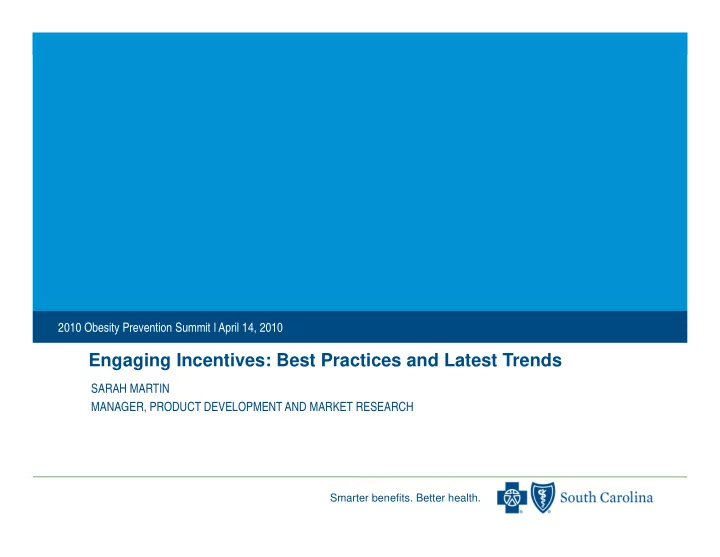

2010 Obesity Prevention Summit l April 14, 2010 Engaging Incentives: Best Practices and Latest Trends SARAH MARTIN MANAGER, PRODUCT DEVELOPMENT AND MARKET RESEARCH Smarter benefits. Better health.
Wellness Program Models Traditional Population Quality of Life Approach Health Mgt • Fun activity • Health focus • Add productivity • Voluntary • All voluntary • Some required activity • Site based only • Site-based only • Site and virtual • No spouses • Some spouses • Spouses • Not HCM oriented • Limited HCM oriented • HCM oriented • Minimal incentives • Modest incentives • Major incentives • No risk reduction • Some risk reduction • Strong risk reduction • No high risk focus • Little high risk focus • Strong high risk focus • No evaluation • Weak evaluation • Strong evaluation Morale Morale Activity Activity Results Results Oriented Oriented Oriented Oriented Oriented Oriented Smarter benefits. Better health. Source: Chapman, Using Wellness Incentives, 2002
Connecting Incentives to Wellness Population Health Mgt Traditional • Benefit Approach Based Incentives • Gift Cards • Premium Quality Reductions of Life • Trinkets Smarter benefits. Better health.
Putting Yourself in Their Shoes… Health Fairs Lunch and Learns Health Risk Assessments Biometric Screenings Smarter benefits. Better health.
[ Fact: Employees by default are not interested in changing their behaviors …and they don’t want to be forced to by their employer] Smarter benefits. Better health.
Tips for thinking about incentives Risk areas Tools Generational considerations Confidentiality Taxes Law (HIPAA, GINA, ADA) Leveraging existing programs Plan design options Smarter benefits. Better health.
And then this little thing called health reform happened… Grants for small businesses to provide comprehensive workplace wellness programs Defines prevention promotion services to include telephonic, face to face and web-based intervention efforts on weight management, physical fitness, nutrition, healthy lifestyle support and diabetes prevention 20% changes to 30% Reiterates ADA and HIPAA Wellness demonstration project – 10 state incubator Smarter benefits. Better health.
[ Fact: The same incentives that motivate your employees yesterday and today are not the same incentives that will motivate them tomorrow.] Smarter benefits. Better health.
53% Full coverage of preventive services 53% Completion of a HRA 42% Participation in health improvement or dm 40% Participation in smoking cessation program 31% Participation in weight management program 21% Management of cholesterol level, blood pressure 12% Completion of consumer education module 7% Maintaining a personal health record Over 50% of employers provide incentives, 6% are sticks Smarter benefits. Better health. Hays Companies
Incentive Options: Carrot or Stick? $50 to $250 can achieve 50%-80% participation rates Require the completion of a health risk assessment or participation in a program Mandatory programs with a stick usually pay for themselves in year one, and yield a 6:1 ROI or better in subsequent years When employers motivate the majority of employees to participate in a health care plan, the cross-section of participants becomes representative of the entire employee population Smarter benefits. Better health. Hays Companies
Incentive Models: IBM • Employees get up to two $150 payments a year for completing HRAs and meeting specific requirements such as weight loss, diet change, or attainment of physical fitness goals • Rebate for employees who establish healthy eating and exercise routines for their children • Rebate for new employees who complete an online health assessment and visit Web-based health resource Smarter benefits. Better health.
Incentive Models: State of Alabama Starting in January 2010: • $25 premium discount to employees who don’t use tobacco • $25 monthly premium for tobacco users rises to $50 in 2011 • $25 “wellness premium discount” for employees who meet standards for blood pressure, cholesterol, glucose, and BMI • Anyone whose results fall outside certain boundaries receives a voucher that covers the co-payment for a doctor’s visit. • Beginning in 2011, employees can receive the discount if they meet health standards or are taking steps to get healthier • No wellness premium discount for employees who don’t take health risk assessments and/or steps to reduce their health risks Smarter benefits. Better health.
Incentive Models: Scotts Miracle-Gro $10 monthly fitness center fee, reimbursable after 120 uses Free health coaching Free medical services for employees and covered dependents Free prescriptions for generic drugs Voluntary health-risk appraisal but employees who choose not to participate pay a $40-per-month insurance premium surcharge If mid to high risk they can opt to consult a health coach and take steps to lower risks. However, if that employee chooses to do nothing, they will pay a $67 insurance premium surcharge per month Smarter benefits. Better health.
Incentive Models: The Safeway Model • Provide employees rebates on health insurance premiums for remaining within limits on four common medical risk factors - smoking, obesity, blood pressure and cholesterol. • A state-of-the-art onsite fitness center • Free lunch at the company cafeteria for every eight visits to the gym • Subsidized cafeteria, which offers lots of vegetarian fare • Portion size, calorie count, cholesterol and fiber count posted for all prepared meals in the cafeteria Smarter benefits. Better health.
What are we seeing? Smarter benefits. Better health.
[ The rise of value based benefits ] Smarter benefits. Better health.
The Rise of Value Based Benefits Member Level Benefit Group Benefit • Targets high cost conditions • Can remove barriers to care or… • Establish financial barrier to “non proven” services Smarter benefits. Better health.
[ Question: Would it motivate you? ] Smarter benefits. Better health.
Smarter benefits. Better health. Smarter benefits. Better health.
Recommend
More recommend